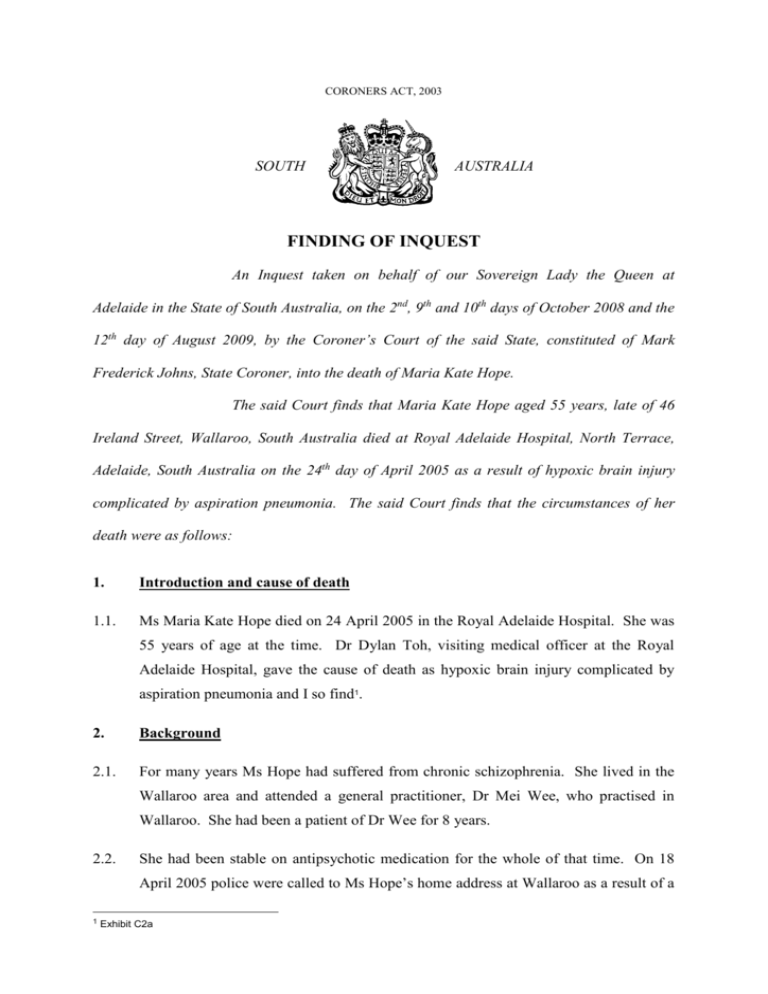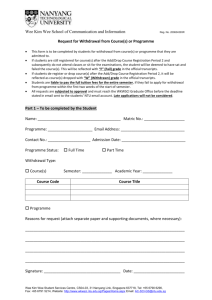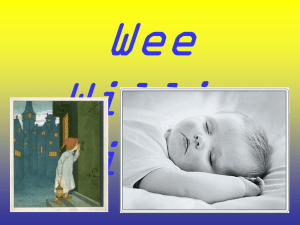HOPE Maria Kate
advertisement

CORONERS ACT, 2003 SOUTH AUSTRALIA FINDING OF INQUEST An Inquest taken on behalf of our Sovereign Lady the Queen at Adelaide in the State of South Australia, on the 2nd, 9th and 10th days of October 2008 and the 12th day of August 2009, by the Coroner’s Court of the said State, constituted of Mark Frederick Johns, State Coroner, into the death of Maria Kate Hope. The said Court finds that Maria Kate Hope aged 55 years, late of 46 Ireland Street, Wallaroo, South Australia died at Royal Adelaide Hospital, North Terrace, Adelaide, South Australia on the 24th day of April 2005 as a result of hypoxic brain injury complicated by aspiration pneumonia. The said Court finds that the circumstances of her death were as follows: 1. Introduction and cause of death 1.1. Ms Maria Kate Hope died on 24 April 2005 in the Royal Adelaide Hospital. She was 55 years of age at the time. Dr Dylan Toh, visiting medical officer at the Royal Adelaide Hospital, gave the cause of death as hypoxic brain injury complicated by aspiration pneumonia and I so find1. 2. Background 2.1. For many years Ms Hope had suffered from chronic schizophrenia. She lived in the Wallaroo area and attended a general practitioner, Dr Mei Wee, who practised in Wallaroo. She had been a patient of Dr Wee for 8 years. 2.2. She had been stable on antipsychotic medication for the whole of that time. On 18 April 2005 police were called to Ms Hope’s home address at Wallaroo as a result of a 1 Exhibit C2a 2 disturbance. Ms Hope was found to have been throwing stones at a neighbour’s house. Police conveyed Ms Hope to the Wallaroo Hospital where Dr Wee saw her later that day. Ms Hope remained in the hospital for the rest of the day until shortly after 9pm when she was discovered by nursing staff with a plastic bin liner over her head, tied by a piece of white cord around her neck. She was in cardio respiratory arrest and was transferred to the Royal Adelaide Hospital where she died 6 days later. This Inquest examined the circumstances of her hospitalisation on 18 April 2005. 3. Ms Hope’s medical history 3.1. Dr Wee gave evidence that Ms Hope had a long and chronic case of schizophrenia for which she had been treated using the antipsychotic medication, Mellaril, and the accompanying drug, Artane, which suppressed certain side effects arising from the Mellaril. Dr Wee described her as stable on these drugs and as a regular visitor to the surgery for the purposes of obtaining fresh prescriptions. Dr Wee said that she was always a very tidy, well-kept lady and was softly spoken2. 3.2. Dr Wee said that she changed Ms Hope’s drug regime in late 2003/early 2004 because Mellaril was no longer going to be available to patients. She was moved to the antipsychotic medication Zyprexa. After some time Ms Hope reported that she was coping well on the Zyprexa3. In summary, Dr Wee said that she was stable, and had been stable, for a very long time4. 4. 18 April 2005 4.1. On 18 April 2005 Dr Wee received a telephone call from the police to advise that her patient, Ms Hope, was throwing stones into her neighbour’s property. Dr Wee asked the police to bring Ms Hope to the Wallaroo Hospital so that she could be assessed5. 4.2. Later that morning, at approximately 9:20am, Dr Wee received a telephone call from the hospital to advise her that Ms Hope had been admitted. She was informed that Ms Hope was calm, quiet and there was no problem with her behaviour. Dr Wee instructed Sister Gordon to admit Ms Hope and to start her on Zyprexa, 10mg 6. Dr Wee had a list of patients to see and she continued to work her way through her 2 Transcript, pages 18-19 Transcript, page 21 4 Transcript, page 22 5 Transcript, page 22 6 Transcript, page 24 3 3 patient list for that morning. She received an update from Sister Gordon at 11am to advise that Ms Hope was under control and calm. Dr Wee asked that Sister Gordon arrange for the mental health team to become involved with the management of Ms Hope, or at least arrangements for that to be put in hand. Dr Wee understood that there was no urgency for her to attend the hospital immediately because the situation was under control7. 4.3. Dr Wee attended at the Wallaroo Hospital at 12:45pm and saw Ms Hope. Sister Gordon informed her that Ms Hope had remained calm and that she had refused to see the mental health practitioners. She was placed in a room set aside for mental health patients, which was very close to the nurses’ station to facilitate frequent observations. Dr Wee described it as a purpose-built room with a viewing window that faces the nurses’ station8. Dr Wee attended upon Ms Hope and noted that she was sitting on the bed quietly. She was neatly dressed and tidy and did not smell of alcohol. She was clean but not communicative, although polite in her answers9. 4.4. Dr Wee asked Ms Hope about the events of the morning but Ms Hope was incommunicative. She told Dr Wee that she was ‘alright now’ but Dr Wee said that she would like Ms Hope to remain in hospital for a few days so that her medication could be stabilised. Ms Hope did not object to that course and Dr Wee said that she would like Ms Hope to see the mental health nurse. Ms Hope did not say no, despite her earlier objections to the nursing staff of the hospital, and Dr Wee took it that she had changed her mind10. Dr Wee’s assessment was that the crisis, which had brought Ms Hope into the hospital, had subsided, her mental state had settled and that she could be safely treated in the rural hospital environment of Wallaroo Hospital. Dr Wee’s plan was to stabilise Ms Hope on her medication and if there was any further concern over the ensuing few days of hospitalisation, Dr Wee would be able to arrange for a semi urgent psychiatric review over the telephone11. 4.5. Dr Wee said that she did consider whether or not to detain Ms Hope under the Mental Health Act but decided not to. She said that she decided not to detain Ms Hope because she was quiet and settled and was neither a potential harm to herself or 7 Transcript, pages 24-25 Transcript, page 29 9 Transcript, page 29 10 Transcript, page 31 11 Transcript, page 31 8 4 others12. Dr Wee said that it was not a difficult thing to detain a patient and that if she were to do so, she would contact the Rural and Remote Health Service in Adelaide and advise them of the need to transfer the patient to an approved treatment centre for further management13. Dr Wee understood that the mental health team would review Ms Hope within 24 hours and she was satisfied with that14. Dr Wee did not leave any directions for the hospital staff about frequency of observations. She expected the hospital had its own protocols for dealing with that matter15. 4.6. Dr Wee did not ask Ms Hope whether she had any suicidal thoughts. She explained that this did not arise because Dr Wee had no knowledge of any previous episodes of suicidal behaviour on Ms Hope’s part and that the incident which had brought her into hospital was one in which she appeared to be ‘trying to protect herself rather than to harm herself’16. She also said that she did not believe that Ms Hope was depressed17. 5. Incident during the afternoon 5.1. During the late afternoon Ms Hope was noted by a member of the nursing staff to have a small plastic bag (approximately A4 size) on top of her head. The nursing staff member asked Ms Hope to give them the bag and attended in her room with a second member of staff. Ms Hope willingly gave the first staff member the bag. The staff then removed from the room any equipment they thought might be used by Ms Hope to harm herself. A registered nurse, Ms Barnard, observed the enrolled nurses dealing with Ms Hope at this time. She said that she listened to what was being said about the plastic bag and she looked straight at Ms Hope. The staff also removed the bell cord as a precaution. The registered nurse showed Ms Hope a red call button on the wall above the plug for the bell and told her she could use that if she needed to speak to any of the nurses. One of the nursing staff also noted that Ms Hope had some shoelaces or other cord around her neck. 5.2. The nursing staff asked Ms Hope why she had the plastic bag on her head and she said words to the effect ‘that’s a hat’ and that the things around her neck were a necklace. The staff did not press the point any further with her and were content to 12 Transcript, page 32 Transcript, page 32 14 Transcript, page 33 15 Transcript, pages 35 and 49 16 Transcript, page 37 17 Transcript, page 38 13 5 remove anything they thought might cause a risk of harm18. Unfortunately, the staff did not contact Dr Wee and advise her of this event19. Had they done so, Dr Wee said she would have called the Rural and Remote Health Service and probably made arrangements to detain Ms Hope and transfer her to an approved treatment centre20. 6. Ms Hope is found in respiratory arrest 6.1. Shortly after 9pm that evening, the nursing staff found Ms Hope inside her room with the lights out and a plastic bag over her head. She had stopped breathing but responded to cardiopulmonary resuscitation and was ultimately transferred to the Royal Adelaide Hospital. 6.2. Tragically, Ms Hope had suffered a hypoxic brain injury during the time she was starved of oxygen and died in the Royal Adelaide Hospital on 24 April 2005. 6.3. The plastic bag, which Ms Hope had found, was a rubbish bin liner which staff had overlooked when stripping the room on the earlier occasion21. 7. Changes made at Wallaroo Hospital since Ms Hope’s death 7.1. Mr Andrew Daulby is the Clinical Services Coordinator at Wallaroo Hospital. He acknowledged that the protocols and guidelines at Wallaroo Hospital prior to Ms Hope’s tragic death were rudimentary22. Following her death there were many changes of policy and procedure which were outlined in Mr Daulby’s evidence 23. These changes include new admission forms to ensure a specific consideration of mental health assessments. The changes in procedure involved not only nursing staff but also medical staff and the mental health team. Internal training was run for registered nurses and enrolled nurses which were repeated 5 times over a period of 12 months to ensure that all of the staff were covered. The training specifically covered mental health assessments and the admission and assessment processes that had been developed24. Mr Daulby gave evidence that the Rural and Remote Health Service have developed further resources for country hospitals and are able to provide access 18 Transcript, page 56 Transcript, page 55 20 Transcript, page 56 21 Exhibit C10b 22 Transcript, page 67 23 Transcript, pages 68-79 24 Transcript, page 70 19 6 to a psychiatrist on a 24-hour basis25. The new mental health assessment documentation was introduced in June 2005, that is within 2 months of Ms Hope’s tragic death26. Protocols were also developed for the use of the mental health patient room in which Ms Hope was accommodated27. Furthermore, the lighting system for the room has been changed so that the light is controlled by means of an external switch to prevent a patient such as Ms Hope turning off the light, thus preventing staff from observing them28. 7.2. Mr Derek Wright, Director Mental Health Operations in the Department of Health, also gave evidence in the Inquest. He said that since Ms Hope’s tragic death the Department has appointed a Clinical Director for Mental Health Services for the country. The Department has looked at the work that was done at Wallaroo Hospital following Ms Hope’s death and has reconsidered the training of general health staff to provide a program for training in country regions to assist staff in dealing with mental health patients. The Department has also appointed mental health nurse clinical practitioners to assist in the country regions and has considered the appointment of additional psychiatrists for the country regions. 8. Conclusions and recommendations 8.1. It is most unfortunate that the nursing staff failed to notice the plastic bin liner when stripping Ms Hope’s room. That, combined with the brief period when she was not being observed and her room was in darkness, enabled her to place the bin liner over her head and partially suffocate herself. Had the bin liner been detected it is probable that Ms Hope would not have been able to harm herself at all. Unfortunately, this is simply a case of human error. 8.2. I note the many improvements that have been introduced at Wallaroo Hospital since Ms Hope’s tragic death. Furthermore, there have been changes to the management by the Department of Health of country mental health issues. It is to be hoped that these changes will be positive. Certainly, Dr Tony Davis, Psychiatrist, who provided an overview of this case at the request of counsel assisting the Court, was impressed by 25 Transcript, page 71 Transcript, page 72 27 Transcript, page 76 28 Transcript, pages 76-77 26 7 the changes introduced at Wallaroo Hospital since Ms Hope’s death. He comments as follows: 'I consider that these developments are important and timely, and likely to ensure that patients admitted with acute psychiatric illnesses are adequately assessed and managed following admission to Wallaroo Hospital. These forms and instruments provide a basis for a detailed mental state assessment and a means of developing comprehensive treatment plans for patients, in the short and long term.' 8.3. With respect, I agree with Dr Davis. In the circumstances I do not propose to make any recommendations in this matter. Key Words: Psychiatric/Mental Illness; Hypoxia; Plastic Bag In witness whereof the said Coroner has hereunto set and subscribed his hand and Seal the 12th day of August, 2009. State Coroner Inquest Number 33/2008 (1206/2005)








